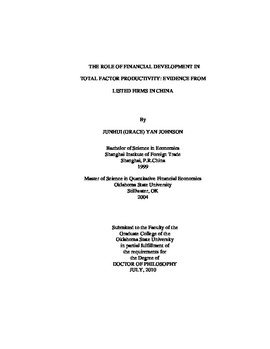| dc.contributor.advisor | Applegate, Michael | |
| dc.contributor.author | Johnson, Junhui (Grace) Yan | |
| dc.date.accessioned | 2013-11-26T08:23:33Z | |
| dc.date.available | 2013-11-26T08:23:33Z | |
| dc.date.issued | 2010-07 | |
| dc.identifier.uri | https://hdl.handle.net/11244/6716 | |
| dc.description.abstract | Scope and Method of Study: This study empirically investigates the relationship between total factor productivity (TFP) and financial development at the firm-level using listed firms in China over the period of 1999 to 2004. Two main channels through which financial development can affect total factor productivity at the firm level are explored: 1. financial constraints and 2. corporate governance. A nonparametric approach by Good et al. (1996) is chosen to estimate the firm-level TFP. Traditional measures such as size and age are used as proxies for the first channel-financial constraints. Inspired by Hadlock and Pierce (2009), size and age are also chosen as predictor variables to calculate a financial constraint score. For the second channel, two dimensions of the corporate governance are examined: financial structure measured by the debt-to-asset ratio and ownership structure proxied by ownership concentration and ownership category. The paper also evaluates the relationship between a firm's characteristics (capital intensity and export orientation) and its TFP level. Pooled OLS and Fixed Effects estimators are used and the Chow tests are conducted to see whether the role of financial development differs across different types of firms. | |
| dc.description.abstract | Findings and Conclusions: This study finds that financial development measured by financial constraints at the firm level is positively associated with TFP: i.e., the easier the access to capital, the higher a firm's TFP. The results show that a high debt-to-asset ratio is associated with a lower firm productivity level, which is consistent with one line of literature. Top ten shareholder concentration has a significant positive relationship, while state-ownership has a significant negative relationship with firm-level TFP. | |
| dc.description.abstract | The positive relationship between financial development and total factor productivity at the firm level implies that the sound financial system that China is trying to build will eventually help the country get on a more sustained economic growth path. In addition, indices created for Chinese listed firms using a more comprehensive set of company factors can provide a way to predict which firms will be financially constrained. | |
| dc.format | application/pdf | |
| dc.language | en_US | |
| dc.rights | Copyright is held by the author who has granted the Oklahoma State University Library the non-exclusive right to share this material in its institutional repository. Contact Digital Library Services at lib-dls@okstate.edu or 405-744-9161 for the permission policy on the use, reproduction or distribution of this material. | |
| dc.title | Role of financial development in total factor productivity: Evidence from listed firms in China | |
| dc.contributor.committeeMember | Kazianga, Harounan | |
| dc.contributor.committeeMember | Rickman, Dan | |
| dc.contributor.committeeMember | Harper, Joel | |
| osu.filename | Johnson_okstate_0664D_10940.pdf | |
| osu.accesstype | Open Access | |
| dc.type.genre | Dissertation | |
| dc.type.material | Text | |
| dc.subject.keywords | china | |
| dc.subject.keywords | financial development | |
| dc.subject.keywords | firm-level total factor productivity | |
| thesis.degree.discipline | Economics | |
| thesis.degree.grantor | Oklahoma State University | |
